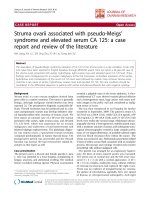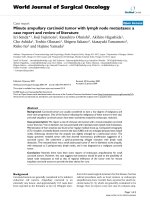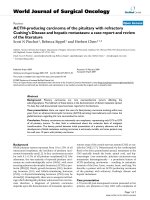Báo cáo y học: "Anti-glomerular basement membrane disease superimposed on membranous nephropathy: a case report and review of the literature" pdf
Bạn đang xem bản rút gọn của tài liệu. Xem và tải ngay bản đầy đủ của tài liệu tại đây (582.25 KB, 5 trang )
CASE REPO R T Open Access
Anti-glomerular basement membrane disease
superimposed on membranous nephropathy:
a case report and review of the literature
Dhruval Patel
1
, Noel Nivera
1
, Allan R Tunkel
1,2*
Abstract
Introduction: Anti-glomerular basement membrane disease is a rare autoimmune disorder characterized by
pulmonary hemorrhage, crescentic glomerulonephritis and the presence of circulating anti-glomerular basement
membrane antibodies. The simultaneous occurrence of both anti-glomerular basement membrane disease and
membranous nephropathy is rare.
Case presentation: A 59-year-old Hispanic man presented with acute onset of nausea and vomiting and was
found to have renal insufficiency. Work-up included a kidney biopsy, which revealed anti-glomerular basement
membrane disease with underlying membranous nephropathy. He was treated with emergent hemodialysis,
intravenous corticosteroids, plasmapheresis, and cyclophosphamide without improvement in his renal function.
Conclusion: Simultaneous anti-glomerular basement membrane disease and membranous nephropathy is very
rare. There have been 16 previous case reports in the English language literature that have been associated with a
high mortality and morbidity, and a very high rate of renal failure resulting in hemodialysis. Co-existence of
membranous nephropathy and anti-glomerular basement membrane disease may be immune-mediated, although
the exact mechanism is not clear.
Introduction
Anti-glomerular basement membrane (anti-GBM) dis-
ease is a rare autoimmune disorder with significant
morbidity and mortality and is characterized by pulmon-
ary h emorrhage, crescentic glomerulonephritis, and the
presence of circulating anti-GBM antibodies which bind
to the alpha-3 chain of type 4 collagen found in the glo-
merular and alveolar basement membranes [1]. The
etiology of anti-GBM disease is unclear, but may result
from hydrocarbon exposure; specific HLA molecules
have also been found to be associated with disease.
Anti-GBM disease accounts for approximately 10 to
20 percent of patients with rapidly progressive crescentic
glomerulonephritis in the United States. The diagnosis is
established by demonstration of high titers of anti-GBM
antibodies in the circulation and/or renal biopsy. Early
treatment with high-dose corticosteroids, plasmapheresis
and cyclophosphamide is recommended because early
and appropriate treatment may reverse the extent of
renal damage and potentially prevent the need for life-
long dialysis. In untreated patients, anti-GBM disease
progresses to renal failure and death. There have been
very few case reports documenting the simultaneous
appearance of anti-GBM disease a nd membrano us
nephropath y. Here, w e present a case of combined dis-
ease, and review the literature on this important, but
rare, condition.
Case presentation
A 5 9-year-old Hispanic man with no known significant
past medical history was well until two weeks prior to
presentation when he noted some chest congestion and
early morning nausea. One week later, he presented to a
local walk-in clinic where he was treated with hydroco-
done, chlorpheniramine (Tussionex), and ciprofloxacin
without improvement. Five days later, he presented to
our Emergency Department with complaints of nausea,
vomiting, fatigue, decreased urination, a nd generalized
malaise. He denied hemoptysis, hematuria, rash, or use
* Correspondence:
1
Department of Internal Medicine, Monmouth Medical Center, Long Branch,
NJ, USA
Patel et al. Journal of Medical Case Reports 2010, 4:237
/>JOURNAL OF MEDICAL
CASE REPORTS
© 2010 Patel et al; licensee BioMed Central Ltd. This is an Open Access article distributed under t he terms of t he Creative Co mmons
Attribution License ( which permits unrestricted use, distribution, and reproduction in
any medium, provided the original work is properly cited.
of non-steroidal anti-inflammatory agents. He believed
that he had received a blood transfusion during the
Vietnam War secondary to bleeding after a forearm
injury. Physical examination revealed that his tempera-
ture was 98.2°F, pulse 88 per minute, respirator y rate
20 per minute, and blood pressure 160/78 mmHg.
Examination was otherwise unremarkable.
Laboratory studies revealed a serum creatinine of
25 mg/dL (normal range 0.6 to 1.2 mg/dL), BUN
175 mg/dL (normal range 5 to 21 mg/dL), hemoglobin
10 gm/dL (normal range 13.5 to 18 gm/dL), and hema-
tocrit 28.9% (normal range 41 to 54%). Urine analysis
showed proteinuria of over 300 mg, too numerous to
count red blood cells per high power fie ld, and too
numerous to count white blood cells per high power
field; the urine was negative for eosinophils, red blood
cell casts and Bence Jones protein. Serum potassium
and phosphorus were 5.0 mg/dL and 9.4 mg/dL, respec-
tively. Serum albumin was 3.1 gm/dL (normal range 3.5
to 5.0 gm/dL). ANA, C-ANCA, P-ANCA, hepatitis
panel, and HIV antibody tests were negative. Serum pro-
tein electrophoresis, creatine phosphokinase, quantita-
tive Immunoglobin assay, complement levels and chest
radiograph were all normal. A renal ultrasound showed
that the kidneys were of normal size. He was started on
hemodialys is and methylprednisolone one gram intrave-
nously daily. Kidney biopsy revealed cellular crescents in
all 20 gl omeruli seen on the biopsy specimen (Figure 1).
Immunofluorescent staining revealed linear glomerular
capillary wall positivity of 3+ intensity for IgG with C3,
3+ kappa and 2+ lambda (Figure 2), supporting the
diagnosis of anti-GBM disease. Electron microscopy
revealed global subep ithelial deposits, diagnostic of
membranous glomerulopathy (Figure 3). The serum
anti-GBM antibody was positive with titer of over
100 units/mL. He was started on plasmaphare sis, cyclo-
phosphamide and prednisone, and was maintained on
hemodialysis. There was no significant improvement in
his renal function. He is being maintained on hemodia-
lysis after six months following his initial presentation.
He is currently awaiting kidney transplantation.
Discussion
This case of co-existing anti-GBM disease and membra-
nous nephropathy is very rare. His biopsy showed 20
out of 20 glomeruli visualized revealing acute and severe
cellular crescents on light microscopy. Immunofluoros-
cence staining revealed linear glomerular capillary wall
positivity of 3+ intensity for IgG with 1-2+ C3, 3+
kappa and 2+ lambda, supporting the diagnosis of anti-
GBM disease. In addition, electron microscopy revealed
subepithelial global deposits, diagnostic of membranous
Figure 1 Light microscopy revealed cellular crescents in all
sampled 20 glomeruli with extensive fibrinoid necrosis and
neutrophil margination.
Figure 2 Immunofluorescence findings of linear glomerular
capillary wall positivity of 3 + intensity for IgG with 1-2+ C3,
3+ kappa and 2+ lambda support the diagnosis of anti GBM
disease.
Figure 3 Electron mic roscopy showed global subepithelial
deposits which is diagnostic for underlying membranous
glomerulopathy stage 3.
Patel et al. Journal of Medical Case Reports 2010, 4:237
/>Page 2 of 5
glomerulopathy. The findings of membranous glomeru-
lopathy were chronic and predated the development of
ant i-GBM disease. He presented with an unusually high
serum creatinine of 25 mg/dL, consistent with extensive
renal damage at the time of presentation.
A review of the literature revealed 16 previously
reported cases. (Table 1) [2-16]. The mean age of the
patients was 46 years (range 19 to 65 years), with a pre-
dominance of men (11 cases). Four patients had pul-
monary involvement i n the form of Goodpasture ’s
syndrome at the time of presentation. The mean serum
creatinine level at presentation was 8.8 mg/dL (range
0.7 to 25 mg/dL). Eight patients presented with edema,
three with hemoptysis, two with cough, two with hema-
turia, and one patient had fever and a sore throat; our
patient presented with nausea and oliguria. The o ut-
come was poor as four patients died and nine patient s
remained on hemodialysis despite treatment with corti-
costeroids and plasmapheresis. Only three patients had
a good prognosis without the need for hemodialysis; of
these patients, the serum creatinine on presentation was
1.2 mg/dL, 3.0 mg/dL and 0.7 mg/dL, indicating that
these patients had less renal damage. Five of the patients
who initially had membranous nephropathy followed by
anti-GBM disease were middle aged to elderly, in con-
trast to five cases of anti-GBM disease preceding mem-
branous nephropathy in which all were young adults
[15]. Savige et al. also reported six patients with both
anti-GBM disease and membranous nephropathy, all of
whom were treated with steroids, cyclophosphomide
and plasmapheresis. Five of the six patients were
between the ages of 15 to 22 years and recovered well;
another patient was 47 years old and remained dialysis
dependent [17]. Interestingly, in these younger patients,
hematuria and/or hemoptysis were the presenting symp-
toms, in contrast to the middle age group who initially
presented with edema consistent with membranous glo-
merulonephritis, followed by anti-GBM disease. The
proteinuria ranged from trace to 20.7 gm/24 hr, depend-
ing on extent of renal damage.
Immunologic mechanisms involved in the pathogen-
esis of anti-GBM disease may directly or indirectly lead
to the genesis of membranous-type deposits. It is possi -
ble that the intramembranous and epimembranous
immune complexes found in membranous nephropathy
alter the glomerular basement membrane, causing
release of normal or altered glomerular basement mate-
rial with subsequent development of anti-GBM antibo-
dies and crescentic glomerulonephritis. Induced
autoimmune disease i n brown Norway rats with mercu-
ric chloride demonstrated initial anti-GBM disease with
linear immunoglobulin deposit formation together with
formation of autoantibodies directed against multiple
basement membrane proteins and proteoglycan
Table 1 Characteristics of 17 patients with combined anti-GBM disease and membranous nephropathy
Case Number
[ref #]
Age/Sex Initial serum creatinine (mg/
dL)
Clinical presentation Treatment Outcome
1 [2] 49/M 18.0 Edema Steroids Died
2 [3] 53/M 13.0 Edema Steroids, azathioprine Hemodialysis
3 [3] 44/M 3.1 Edema Steroids Hemodialysis
4 [4] 20/F 1.2 Cough, syncope None Survived
5 [5] 19/F 10.5 Hemoptysis Steroids (p)*, azathioprine,
nephrectomy
Hemodialysis
6 [6] 25/M 2.1 Hemoptysis Steroids, PP** Died
7 [7] 65/M 4.0 Edema Steroids, PP, cyclophosphamide Died
8 [8] 20/M 3.0 Fever, sore throat, lumbar
pain
Steroids, PP Survived
9 [9] 54/M 1.1 Cough, arthralgia Steroids, PP Hemodialysis
10 [10] 60/M 19.5 Fatigue, anorexia, edema Steroids (p), PP Hemodialysis
11 [11] 57/not
reported
11.8 Fatigue, hemoptysis Steroids (p), PP, cyclophosphamide Hemodialysis
12 [12] 50/M 0.7 Edema Steroids (p), PP, cyclophosphamide Survived
13 [13] 50/F 8.9 Edema, nausea Steroids (p), PP Hemodialysis
14 [14] 54/F 8.9 Hematuria Steroids, PP Hemodialysis
15 [15] 49/M 7.3 Hematuria, flank pain,
fatigue
Steroids, PP, cyclophosphamide Hemodialysis
16 [16] 50/F 11.6 Edema Steroids, PP, cyclophosphamide Hemodialysis
17 (present
case)
59/M 25.0 Fatigue, oliguria, nausea Steroids, PP, cyclophosphamide Hemodialysis
PP, plasmapheresis; p, pulse steroid therapy
Patel et al. Journal of Medical Case Reports 2010, 4:237
/>Page 3 of 5
components [18]. Membranous deposits may subse-
quently arise from in situ immune complex formation
in anti-GBM disease, increasing antigen synthesis by
injured podocytes and facilitated by the capping and
shedding of antigen-antibody complexes into the sube-
pithelial space. Alternatively, anti-GBM antibodies might
arise after glomerular basement membrane damage that
occurs as a vasculitis involving the glomerular capil-
laries; damage to the glomerular basement membrane
might uncover “hidden antigens”,inducingtheforma-
tion of antibodies to this membrane. This mechanism
may also explain anti-GBM disease after primary glo-
merulonephritis such as membranous nephropathy or
IgA glomerulonephritis [19].
Conclusion
Anti-GBM disease is a reversible cause of renal failure
if diagnosed and treated in the early stages of disease.
Recurrence following successful treatment is low and,
even in patients who have undergone transplantation,
there is a low likelihood of involvement in the trans-
planted kidney. Anti-GBM disease superimposed on
membranous nephropathy is very rare; only 16 cases
have been previo usly reported in the English language
literature. Despite treatment with immunosuppressive
agents and/or plasmapheresis, most of the patients
remained on hemodialysis. Knowing the significant
toxicity from treatment with cyclophosphomide and
corticosteroids, their role in treatment of patients with
anti-GBM disease and concurrent membranous
nephropathy in middle-aged patients with higher
serum creatinine levels and extensive renal involve-
ment on presentation is debatable and needs more
study. Patients who presented with a low serum creati-
nine, and were younger, were more likely to respond
to cytotoxic treatment and have a favorable outcome.
Advances in elucidating the structure of the glomerular
basement membrane antigen and the identification of
the pathogenic B and T cell epitopes, along with new
insights into the pathogenetic mechanisms at the cellu-
lar and molecular level, will facilitate the development
of targeted strategies for prevention, detection, and
treatment of human anti-GBM antibody glomerulone-
phritis [20]. It is presentl y unclear whether crescentic
transformation of underlying membranous nephropa-
thy implies an increase in the severity of the disease or
development of a second process. Optimal treatment
regimens need to be clarified and further research in
this area is necessary.
Consent
Written informed consent was obtained from the patien t
for publication of this case report and any accompanying
images. A copy of the written consent is available for
review by the Editor-in-Chief of this journal.
Acknowledgements
The authors would like to thank Dr. Markowitz, Pathologist at Columbia
University Medical Center, NY for providing biopsy descriptions and figures.
Author details
1
Department of Internal Medicine, Monmouth Medical Center, Long Branch,
NJ, USA.
2
Department of Medicine, Monmouth Medical Center, 300 Second
Avenue, Long Branch, NJ 07740, USA.
Authors’ contributions
DP made substantial contributions to conception and design, acquisition,
analysis and interpretation of data. NN and AT were involved in drafting the
manuscript or revising it critically for important intellectual content. All
authors read and approved the final manuscript.
Competing interests
The authors declare that they have no competing interests.
Received: 25 December 2009 Accepted: 2 August 2010
Published: 2 August 2010
References
1. Kalluri R, Wilson CB, Weber M, Gunwar S, Chonko AM, Neilson EG,
Hudson BG: Identification of the a3 chain of type IV collagen as the
common autoantigen in antibasement membrane disease and
Goodpasture syndrome. J Am Soc Nephrol 1995, 6:1178-1185.
2. Klassen J, Elwood C, Grossberg AL, Milgrom F, Montes M, Sepulveda M,
Andres GA: Evolution of membranous nephropathy into anti-glomerular-
basement-membrane glomerulonephritis. N Engl J Med 1974,
290:1340-1344.
3. Moorthy AV, Zimmerman SW, Burkholder PM, Harrington AR: Association of
crescentic glomerulonephritis with membranous glomerulonephropathy:
a report of three cases. Clin Nephrol 1976, 6:319-325.
4. Agodoa LCY, Striker GE, George CRP, Glassock R, Quadracci LJ: The
appearance of nonlinear deposits of immunoglobulins in Goodpasture’s
syndrome. Am J Med 1976, 61:407-413.
5. Pasternack A, Tornroth T, Linder E: Evidence of both anti-GBM and
immune complex mediated pathogenesis in the initial phase of
Goodpasture’s syndrome. Clin Nephrol 1978, 9:77-85.
6. Sharon Z, Rohde RD, Lewis EJ: Report of a case of Goodpasture’s
syndrome with unusual immunohistology and antibody reactivity. Clin
Immunol Immunopathol 1981, 18:402-414.
7. Richman AV, Rifkin SI, McAllister CJ: Rapidly progressive
glomerulonephritis combined antiglomerular basement membrane
antibody and immune complex pathogenesis. Hum Pathol 1981,
12:597-604.
8. Pettersson E, Tornroth T, Miettinen A: Simultaneous anti-glomerular
basement membrane and membranous glomerulonephritis: case report
and literature review. Clin Immunol Immunopathol 1984, 31:171-180.
9. Kurki P, Helve T, von Bonsdorff M, Törnroth T, Pettersson E, Riska H,
Miettinen A: Transformation of membranous glomerulonephritis into
crescentic glomerulonephritis with glomerular basement membrane
antibodies. Nephron 1984, 38:134-137.
10. Hayano K , Miura H, Fukui H, Otsuka Y, Hattori S: A case of anti-GBM
nephritis (crescentic glomerulonephritis) associated with membranous
nephropathy. Jpn J Nephrol 1992, 7:821-826.
11. Thitiarchakul S, Lal SM, Luger A, Ross G: Goodpasture’s syndrome
superimposed on membranous nephropathy. A case report. Int J Artif
Organs 1995, 18:763-765.
12. Meisels IS, Stillman IE, Kuhlik AB: Anti-glomerular basement membrane
disease and dual positivity for antineutrophil cytoplasmic antibody in a
patient with membranous nephropathy. Am J Kidney Dis 1998, 32:646-648.
13. Nguyen BP, Reisin E, Rodriguez FH: Idiopathic membranous
glomerulopathy complicated by crescentic glomerulonephritis and renal
vein thrombosis. Am J Kidney Dis 1988, 12:326-328.
Patel et al. Journal of Medical Case Reports 2010, 4:237
/>Page 4 of 5
14. Sano T, Kamata K, Shigematsu H, Kabayashi Y: A case of anti glomerular
basement membrane glomerulonephritis superimposed on
membranous nephropathy. Nephro Dial Transplant 2000, 15:1238-1241.
15. Troxell ML, Saxena AB, Kambham N: Concurrent anti glomerular basement
membrane disease and membranous glomerulonephritis. Clin Nephrol
2006, 66:120-127.
16. Nayak S, Satish R: Crescentic transformation in primary membranous
glomerulopathy: association with anti GBM antibody. Saudi J Kid Dis
Transplantion 2007, 18:599-602.
17. Savige J, Dowling J, Kincaid-Smith P: Superimposed glomerular immune
complexes in anti glomerular basement membrane disease. Am J Kidney
Dis 1989, 14:145-153.
18. Nasr SH, Ilamathi ME, Markowitz GS, D’Agati VD: A dual pattern of
immunofluorescence positivity. Am J Kid Dis 2003, 42:419-426.
19. Serratrice J, Chiche L, Dussol B, Granel B, Daniel L, Jego-Desplat S, Disdier P,
Swiader L, Berland Y, Weiller PJ: Sequential development of perinuclear
ANCA-associated vasculitis and anti-glomerular basement membrane
glomerulonephritis. Am J Kidney Dis 2004, 43:e26-30.
20. Borza DB: Autoepitopes and alloepitopes of type IV collagen: role in the
molecular pathogenesis of anti-GBM antibody glomerulonephritis.
Nephron Exp Nephrol 2007, 106:e37-43, Epub.
doi:10.1186/1752-1947-4-237
Cite this article as: Patel et al.: Anti-glomerular basement membrane
disease superimposed on membranous nephropathy: a case report and
review of the literature. Journal of Medical Case Reports 2010 4:237.
Submit your next manuscript to BioMed Central
and take full advantage of:
• Convenient online submission
• Thorough peer review
• No space constraints or color figure charges
• Immediate publication on acceptance
• Inclusion in PubMed, CAS, Scopus and Google Scholar
• Research which is freely available for redistribution
Submit your manuscript at
www.biomedcentral.com/submit
Patel et al. Journal of Medical Case Reports 2010, 4:237
/>Page 5 of 5









